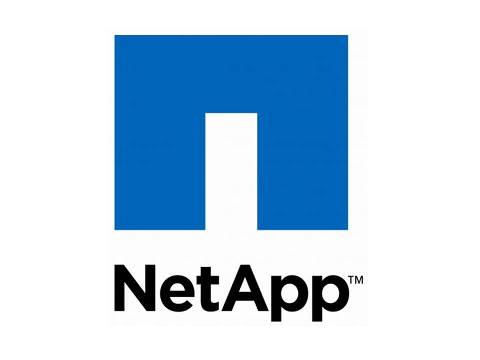 Since last year I’m doing some more work on our NetApp infrastructure.
Since last year I’m doing some more work on our NetApp infrastructure.
Since I don’t have any training in storage management and certainly not in NetApp devices, I was always afraid to do something because I couldn’t test it. I have some basic knowledge and some experience in home storage solutions like Freenas and Openfiler that helped me allot to get the basics in Netapp.
Surfing the NetApp site I found out that they have a simulator … mmmm intresting
Do you want to build or test a solution but don’t have access to NetApp storage? The Data ONTAP simulator, a tool that gives you the experience of administering and using a NetApp storage system with all the features of Data ONTAP at your disposal, is the answer. Download the simulator; discuss usage; and share your experience, technical articles, and best practices here.
This seems perfect for me to get some more experience in the NetApp environment and trying out solutions before I implement them.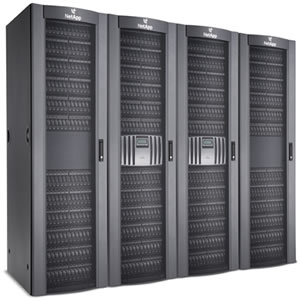
So I went on and tried it out. Here is how to set it up:
First of all download the ISO from the Netapp website
(I downloaded version 7.3.5 because that is the current version in production)
The link to the simulator download page (login required):
http://now.netapp.com/NOW/cgi-bin/simulator
Since I have a vmware test environement I will install the simulator on a virtual machine.
Let’s start the installation
We will need a virtual machines to start building our simulated environement
I will be naming the linux machine TST-O735-SLES01 with ip 192.168.0.91 and the filer itself
will be named TST-O735-FS01 and ip 192.168.0.101.
Create a virtual machine with following specs:
- 1 vCPU
- 1GB Ram
- Hardisk – 40GB
- Delete the floppy
- Network to you’re operational lan
To run the simulator on a virtual machine promiscuous mode must be enabled on the vSwitch.
The underlying OS will be a SUSE Linux Enterprise Server 11 64-bit (SLES)
I will not go into the basics of installing a SLES.
After the installation of the OS we can start installing the Ontap simulator.
Mount the ISO file into the virtual machine and mount it in the linux box
Run the following as root
TST-O735-SLES01:~ # cd /media/CDROM/ TST-O735-SLES01:/media/CDROM # ls Vmware, Linux and Simulator installation.doc doc runsim.sh disks.tgz license.htm setup.sh disks2.tgz readme.htm sim.tgz TST-O735-SLES01:/media/CDROM # bash setup.sh Script version 22 (18/Sep/2007) Where to install to? [/sim]: <press enter> Would you like to install as a cluster? [no]: <press enter> Would you like full HTML/PDF FilerView documentation to be installed [yes]: <press enter> Continue with installation? [no]: yes Creating /sim Unpacking sim.tgz to /sim Configured the simulators mac address to be [00:50:56:1a:7e:98] Please ensure the simulator is not running. Your simulator has 3 disk(s). How many more would you like to add? [0]: 25 The following disk types are available in MB: Real (Usable) a - 43 ( 14) b - 62 ( 30) c - 78 ( 45) d - 129 ( 90) e - 535 (450) f - 1024 (900) If you are unsure choose the default option a What disk size would you like to use? [a]: f Disk adapter to put disks on? [0]: Use DHCP on first boot? [yes]: no Ask for floppy boot? [no]: <press enter> Checking the default route... You have a single network interface called eth0 (default route) . You will not be able to access the simulator from this Linux host. If this interface is marked DOWN in ifconfig then your simulator will crash. Which network interface should the simulator use? [default]: <press enter> Your system has 707MB of free memory. The smallest simulator memory you should choose is 110MB. The maximum simulator memory is 667MB. The recommended memory is 512MB. How much memory would you like the simulator to use? [512]: <press enter> Create a new log for each session? [no]: yes Adding 25 additional disk(s). Complete. Run /sim/runsim.sh to start the simulator.
The simulated filler is installed on the linux OS now, we can start the simulator now.
It will start up and the first time the simulator boots some initial configurations will need to be answered.
Start the simulator as root
TST-O735-SLES01:/media/CDROM # /sim/runsim.sh runsim.sh script version Script version 22 (18/Sep/2007) This session is logged in /sim/sessionlogs/log-1310499824 NetApp Release 7.3.5: Mon Nov 22 20:37:51 PST 2010 Copyright (c) 1992-2010 NetApp. Starting boot on Tue Jul 12 19:43:44 GMT 2011 Tue Jul 12 19:43:44 GMT [iomem.init.fail:CRITICAL]: Failed to initialize caching module (model name , serial number , part number ) in slot 1. Tue Jul 12 19:43:52 GMT [fmmb.current.lock.disk:info]: Disk v4.16 is a local HA mailbox disk. Tue Jul 12 19:43:52 GMT [fmmb.current.lock.disk:info]: Disk v4.17 is a local HA mailbox disk. Tue Jul 12 19:43:52 GMT [fmmb.instStat.change:info]: normal mailbox instance on local side. Tue Jul 12 19:43:54 GMT [raid.cksum.replay.summary:info]: Replayed 0 checksum blocks. Tue Jul 12 19:43:54 GMT [raid.stripe.replay.summary:info]: Replayed 0 stripes. sparse volume upgrade done. num vol 0. Vdisk Snap Table for host:0 is initialized Tue Jul 12 19:43:57 GMT [vol.language.unspecified:info]: Language not set on volume vol0. Using language config "C". Use vol lang to set language. Tue Jul 12 19:43:57 GMT [rc:notice]: The system was down for 17976693 seconds Tue Jul 12 19:43:57 GMT [useradmin.added.deleted:info]: The role 'compliance' has been added. Tue Jul 12 19:43:57 GMT [useradmin.added.deleted:info]: The group 'Backup Operators' has been modified. /etc/rc is missing. Running configuration dialog. NetApp Release 7.3.5: Mon Nov 22 20:37:51 PST 2010 System ID: 0099927627 () System Serial Number: 987654-32-0 () System Storage Configuration: Multi-Path System ACP Connectivity: NA Model Name: Simulator Processors: 1 slot 0: NetApp Virtual SCSI Host Adapter v0 28 Disks: 25.8GB 3 shelves with LRC slot 1: NetApp Virtual SCSI Host Adapter v1 slot 2: NetApp Virtual SCSI Host Adapter v2 slot 3: NetApp Virtual SCSI Host Adapter v3 slot 4: NetApp Virtual SCSI Host Adapter v4 28 Disks: 25.8GB 3 shelves with LRC slot 5: NetApp Virtual SCSI Host Adapter v5 slot 6: NetApp Virtual SCSI Host Adapter v6 slot 7: NetApp Virtual SCSI Host Adapter v7 slot 8: NetApp Virtual SCSI Host Adapter v8 4 Tapes: VT-100MB VT-100MB VT-100MB VT-100MB Please enter the new hostname []: Tue Jul 12 19:44:05 GMT [shelf.config.multipath:info]: All attached storage on the system is multi-pathed. TST-O735-FS01 Do you want to enable IPv6? [n]: <press enter> Do you want to configure virtual network interfaces? [n]: <press enter> Please enter the IP address for Network Interface ns0 []: 192.168.0.101 Please enter the netmask for Network Interface ns0 [255.255.255.0]: <press enter> Please enter media type for ns0 {100tx-fd, auto} [auto]: <press enter> Please enter the IP address for Network Interface ns1 []: <press enter> Would you like to continue setup through the web interface? [n]: <press enter> Please enter the name or IP address of the IPv4 default gateway: 192.168.0.40 The administration host is given root access to the filer's /etc files for system administration. To allow /etc root access to all NFS clients enter RETURN below. Please enter the name or IP address of the administration host: <press enter> Please enter timezone [GMT]: <press enter> Where is the filer located? []: MyICTRoom What language will be used for multi-protocol files (Type ? for list)?:? Supported language codes are: C (POSIX) ar (Arabic) cs (Czech) da (Danish) de (German) en (English) en_US (English (US)) es (Spanish) fi (Finnish) fr (French) he (Hebrew) hr (Croatian) hu (Hungarian) it (Italian) ja (Japanese euc-j*) ja_v1 (Japanese euc-j) ja_JP.PCK (Japanese PCK(sjis)*) ja_JP.932 (Japanese cp932*) ja_JP.PCK_v2 (Japanese PCK(sjis)) ko (Korean) no (Norwegian) nl (Dutch) pl (Polish) pt (Portuguese) ro (Romanian) ru (Russian) sk (Slovak) sl (Slovenian) sv (Swedish) tr (Turkish) zh (Simplified Chinese) zh.GBK (Simplified Chinese (GBK)) zh_TW (Traditional Chinese euc-tw) zh_TW.BIG5 (Traditional Chinese Big 5) To use UTF-8 as the NFS character set append '.UTF-8' Language codes flagged with "*" are obsolete versions of those language character sets. What language will be used for multi-protocol files (Type ? for list)?:en Setting language on volume vol0 The new language mappings will be available after reboot Tue Jul 12 19:47:22 GMT [vol.language.changed:info]: Language on volume vol0 changed to en Language set on volume vol0 Do you want to run DNS resolver? [n]: <press enter> Do you want to run NIS client? [n]: <press enter> The Shelf Alternate Control Path Management process provides the ability to recover from certain SAS shelf module failures and provides a level of availability that is higher than systems not using the Alternate Control Path Management process. Do you want to configure the Shelf Alternate Control Path Management interface for SAS shelves [n]: <press enter> Setting the administrative (root) password for TST-O735-FS01 ... New password: <type the password> Retype new password: <type the password> Tue Jul 12 19:47:36 GMT [passwd.changed:info]: passwd for user 'root' changed. Tue Jul 12 19:47:37 GMT [tapemc.alias.addOK:info]: Alias st0 automatically added for tape device WWN[0:042:424200:000000]. Tue Jul 12 19:47:37 GMT [dfu.firmwareUpToDate:info]: Firmware is up-to-date on all disk drives Tue Jul 12 19:47:37 GMT [sfu.firmwareUpToDate:info]: Firmware is up-to-date on all disk shelves. Tue Jul 12 19:47:37 GMT [tapemc.alias.addOK:info]: Alias st1 automatically added for tape device WWN[0:142:424200:000000]. Tue Jul 12 19:47:37 GMT [tapemc.alias.addOK:info]: Alias st2 automatically added for tape device WWN[0:242:424200:000000]. Tue Jul 12 19:47:37 GMT [tapemc.alias.addOK:info]: Alias st3 automatically added for tape device WWN[0:342:424200:000000]. Tue Jul 12 19:47:37 GMT [netif.linkUp:info]: Ethernet ns0: Link up. Tue Jul 12 19:47:37 GMT [perf.archive.start:info]: Performance archiver started. Sampling 22 objects and 195 counters. add net default: gateway 192.168.0.40 There are 25 spare disks; you may want to use the vol or aggr command to create new volumes or aggregates or add disks to the existing aggregate. Tue Jul 12 19:47:38 GMT [snmp.agent.msg.access.denied:warning]: Permission denied for SNMPv3 requests from root. Reason: Password is too short (SNMPv3 requires at least 8 characters). Tue Jul 12 19:47:38 GMT [rc:info]: Registry is being upgraded to improve storing of local changes. Tue Jul 12 19:47:38 GMT [rc:info]: Registry upgrade successful. Tue Jul 12 19:47:39 GMT [mgr.boot.disk_done:info]: NetApp Release 7.3.5 boot complete. Last disk update written at Thu Dec 16 18:12:22 GMT 2010 Tue Jul 12 19:47:39 GMT [mgr.boot.reason_ok:notice]: System rebooted after a halt command. This process will enable CIFS access to the filer from a Windows(R) system. Use "?" for help at any prompt and Ctrl-C to exit without committing changes.
Press Ctrl+C to break out of CIFS configuration (I will continue).
Note that you can run the cifs setup command at any time.
Your filer does not have WINS configured and is visible only to clients on the same subnet.Do you want to make the system visible via WINS? [n]:
A filer can be configured for multiprotocol access, or as an NTFS-only
filer. Since multiple protocols are currently licensed on this filer,
we recommend that you configure this filer as a multiprotocol filer
(1) Multiprotocol filer
(2) NTFS-only filer
Selection (1-2)? [1]: 1
CIFS requires local /etc/passwd and /etc/group files and default files
will be created. The default passwd file contains entries for 'root',
'pcuser', and 'nobody'.
Enter the password for the root user []: <type the password>
Retype the password: <type the password>
The default name for this CIFS server is 'TST-O735-FS01'.
Would you like to change this name? [n]: <press enter>
Data ONTAP CIFS services support four styles of user authentication.
Choose the one from the list below that best suits your situation.
(1) Active Directory domain authentication (Active Directory domains only)
(2) Windows NT 4 domain authentication (Windows NT or Active Directory domains)
(3) Windows Workgroup authentication using the filer's local user accounts
(4) /etc/passwd and/or NIS/LDAP authentication
Selection (1-4)? [1]: 3
What is the name of the Workgroup? [WORKGROUP]: <press enter>
Tue Jul 12 19:48:06 GMT [snmp.agent.msg.access.denied:warning]: Permission denied for SNMPv3 requests from this user. Reason: Password is too short (SNMPv3 requires at least 8 characters).
Tue Jul 12 19:48:06 GMT [snmp.agent.msg.access.denied:warning]: Permission denied for SNMPv3 requests from root. Reason: Password is too short (SNMPv3 requires at least 8 characters).
Tue Jul 12 19:48:06 GMT [passwd.changed:info]: passwd for user 'root' changed.
CIFS - Starting SMB protocol...
It is recommended that you create the local administrator account
(TST-O735-FS01\administrator) for this filer.
Do you want to create the TST-O735-FS01\administrator account? [y]:<press enter>
Enter the new password for TST-O735-FS01\administrator:<type the password>
Retype the password:<type the password>
Welcome to the WORKGROUP Windows(R) workgroup
CIFS local server is running.
Logging in for the first time
Data ONTAP (TST-O735-FS01.) login: root Password: <type the password> TST-O735-FS01> Tue Jul 12 19:48:24 GMT [console_login_mgr:info]: root logged in from console
List out the disks to make sure you have them.
TST-O735-FS01> vol status -r
Aggregate aggr0 (online, raid0) (zoned checksums)
Plex /aggr0/plex0 (online, normal, active)
RAID group /aggr0/plex0/rg0 (normal)
RAID Disk Device HA SHELF BAY CHAN Pool Type RPM Used (MB/blks) Phys (MB/blks)
--------- ------ ------------- ---- ---- ---- ----- -------------- --------------
data v4.16 v4 1 0 FC:B - FCAL N/A 120/246784 127/261248
data v4.17 v4 1 1 FC:B - FCAL N/A 120/246784 127/261248
data v4.18 v4 1 2 FC:B - FCAL N/A 120/246784 127/261248
Spare disks
RAID Disk Device HA SHELF BAY CHAN Pool Type RPM Used (MB/blks) Phys (MB/blks)
--------- ------ ------------- ---- ---- ---- ----- -------------- --------------
Spare disks for zoned checksum traditional volumes or aggregates only
spare v4.19 v4 1 3 FC:B - FCAL N/A 1020/2089984 1027/2104448
spare v4.20 v4 1 4 FC:B - FCAL N/A 1020/2089984 1027/2104448
spare v4.21 v4 1 5 FC:B - FCAL N/A 1020/2089984 1027/2104448
spare v4.22 v4 1 6 FC:B - FCAL N/A 1020/2089984 1027/2104448
spare v4.24 v4 1 8 FC:B - FCAL N/A 1020/2089984 1027/2104448
spare v4.25 v4 1 9 FC:B - FCAL N/A 1020/2089984 1027/2104448
spare v4.26 v4 1 10 FC:B - FCAL N/A 1020/2089984 1027/2104448
spare v4.27 v4 1 11 FC:B - FCAL N/A 1020/2089984 1027/2104448
spare v4.28 v4 1 12 FC:B - FCAL N/A 1020/2089984 1027/2104448
spare v4.29 v4 1 13 FC:B - FCAL N/A 1020/2089984 1027/2104448
spare v4.32 v4 2 0 FC:B - FCAL N/A 1020/2089984 1027/2104448
spare v4.33 v4 2 1 FC:B - FCAL N/A 1020/2089984 1027/2104448
spare v4.34 v4 2 2 FC:B - FCAL N/A 1020/2089984 1027/2104448
spare v4.35 v4 2 3 FC:B - FCAL N/A 1020/2089984 1027/2104448
spare v4.36 v4 2 4 FC:B - FCAL N/A 1020/2089984 1027/2104448
spare v4.37 v4 2 5 FC:B - FCAL N/A 1020/2089984 1027/2104448
spare v4.38 v4 2 6 FC:B - FCAL N/A 1020/2089984 1027/2104448
spare v4.39 v4 2 7 FC:B - FCAL N/A 1020/2089984 1027/2104448
spare v4.40 v4 2 8 FC:B - FCAL N/A 1020/2089984 1027/2104448
spare v4.41 v4 2 9 FC:B - FCAL N/A 1020/2089984 1027/2104448
spare v4.42 v4 2 10 FC:B - FCAL N/A 1020/2089984 1027/2104448
spare v4.43 v4 2 11 FC:B - FCAL N/A 1020/2089984 1027/2104448
spare v4.44 v4 2 12 FC:B - FCAL N/A 1020/2089984 1027/2104448
spare v4.45 v4 2 13 FC:B - FCAL N/A 1020/2089984 1027/2104448
spare v4.48 v4 3 0 FC:B - FCAL N/A 1020/2089984 1027/2104448
Adding the licenses:
Open a browser on you’re client and point to: http://192.168.0.101/na_admin/
If you registered the name in you’re dns you can point to: http://TST-O735-FS01/na_admin/
The Simulator is now up and running and can be used like a normal NetApp filler with it’s limitations of cours. The rest of the configuration can be done from the FilerView.
The only thing that rest is adding simulator licenses.
You can find the licenses in the ISO file under the folder doc\license_keys.htm
You can also click the “Simulator Documentation is installed”
Click the License keys …
And voila a list of test licenses for you’re simulated NetApp filer.
Adding a license is as easy as:
Typing it in on the config page in FilerView -> Filer -> Manage Licenses
Or typing it in on the console:
license add <license>
For more info and support here is a link to the community site:
http://communities.netapp.com/community/interfaces_and_tools/simulator
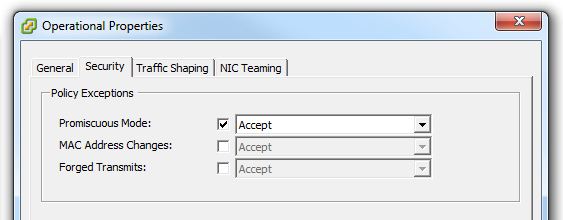
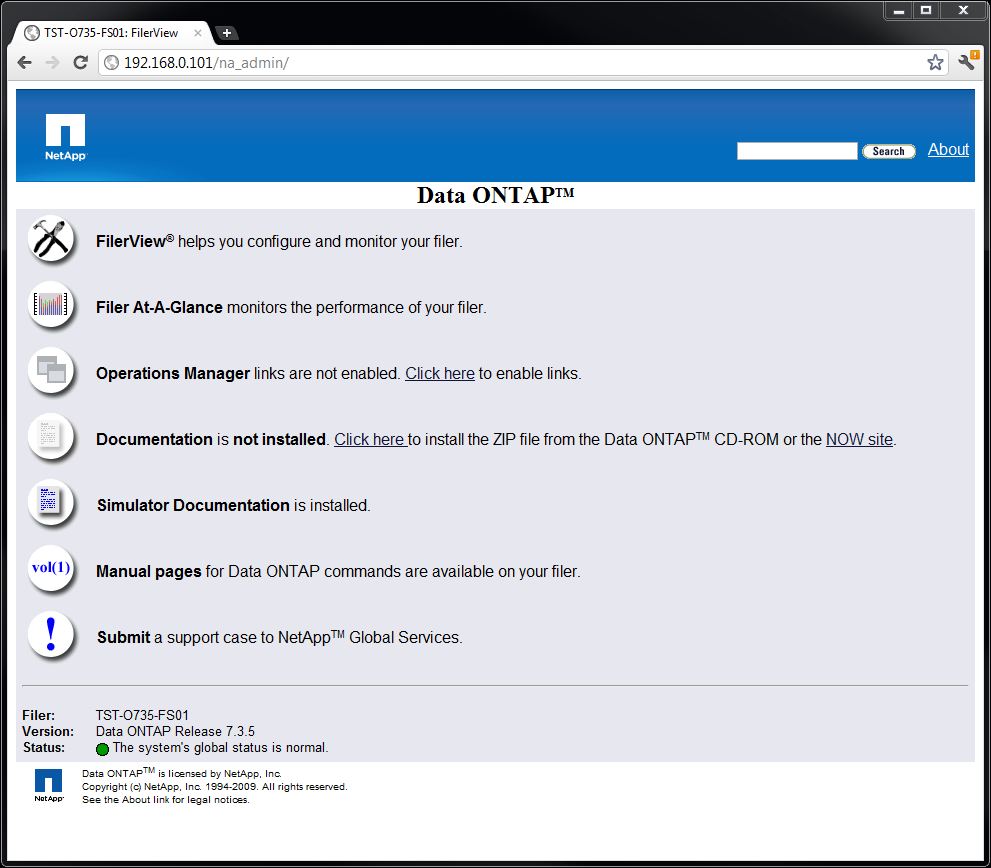

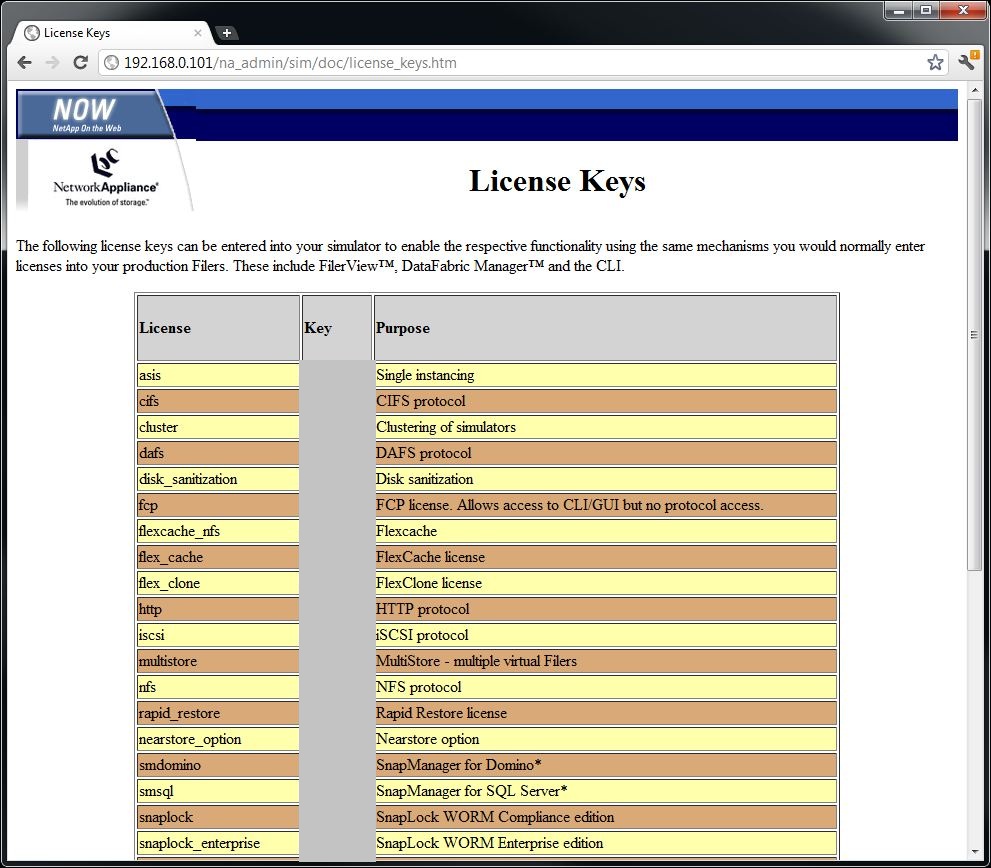
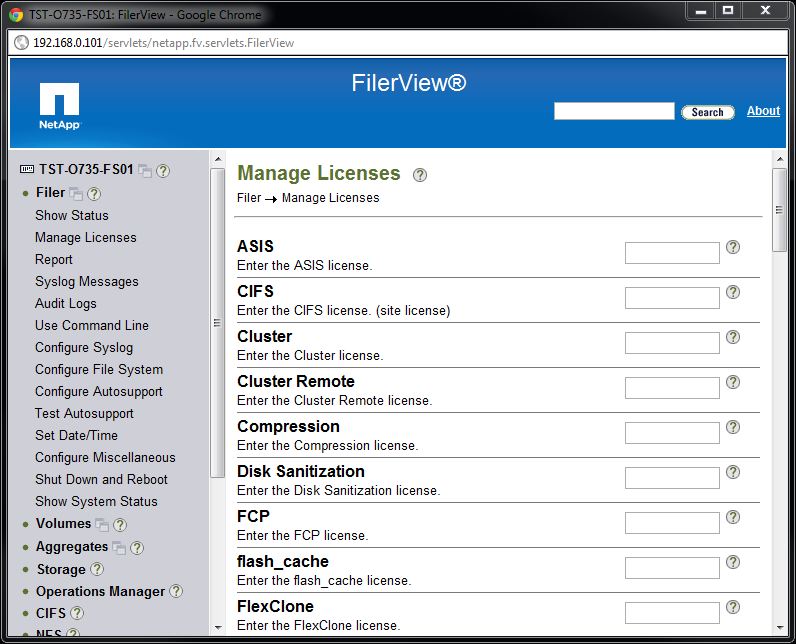
Leave a Reply
You must be logged in to post a comment.